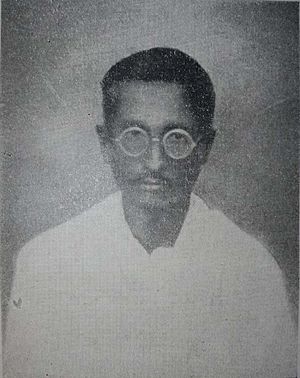Chandra Kumar De facts for kids
Quick facts for kids
Chandra Kumar De
|
|
|---|---|
| চন্দ্রকুমার দে | |
 |
|
| Born | 1889 |
| Died | 1946 (aged 56–57) |
| Occupation | Folklorist |
Chandra Kumar De (Bengali: চন্দ্রকুমার দে, romanized: Chôndrôkumar De; 1889–1946) was a special writer and collector from East Bengal. He loved finding and writing down old stories and songs, called folklore and folk ballads. These stories came from villages, especially in the Greater Mymensingh area, which is now part of Bangladesh.
Today, Chandra Kumar De is known as a very important collector of folk tales in Bengal. The songs and stories he found are a big part of Bengali folk literature. They were published by the University of Calcutta in books like Moimonshingho Gitika (1923) and Purbabanga Gitika (1923-1932). Later, some were even published in English as Eastern Bengal Ballads.
Contents
Who Was Chandra Kumar De?
Chandra Kumar De was born in 1889 in a village called Aithor, in the Netrokona District. His father was Ram Kumar De. Sadly, Chandra Kumar lost both his parents when he was young. This meant he had to start working to support himself very early in life.
He didn't get much formal schooling. He spent a short time studying at a Sanskrit tol, which was a traditional school. But that was most of his education.
How Did Chandra Kumar De Start His Career?
Chandra Kumar's first job was at a small grocery shop. He earned only one rupee a month, which was a very small amount of money. But he wasn't very good at this job and soon lost it.
Later, he got a job working for Taranath Talukder. He became a tahsildar, which was a person who collected taxes. For this job, he earned two rupees a month.
In 1912, Chandra Kumar started writing essays about folklore. These essays were published in a Bengali magazine called Saurabh. The magazine was published from Mymensingh. The editor, Kedarnath Majumder, noticed Chandra Kumar's talent.
Kedarnath Majumder helped Chandra Kumar get another job. This time, he worked for a rich landlord, called a zamindar, in Gouripur. His job was a gomastha, which meant he visited different villages to collect taxes. He earned eight rupees a month.
While traveling to these villages, Chandra Kumar heard many traditional songs and stories. These included kavigan (poetic songs) and pala gan (long narrative songs). He started writing them down. This was the beginning of his important work as a folklore collector.
Collecting Folk Tales for Calcutta University
A famous scholar named Dinesh Chandra Sen read one of Chandra Kumar's essays. It was called 'Mahila Kavi Chandravati' ('Chandravati, the Poetess'). This essay appeared in the Saurabh magazine in 1913. Dinesh Chandra Sen was very impressed by Chandra Kumar's writing.
At that time, Chandra Kumar was again without a job. Dinesh Chandra Sen offered him a special position. He hired Chandra Kumar as a folklore collector for Calcutta University. This was a great opportunity! He earned 70 rupees a month. Three other people were also hired for this important work.
This new job allowed Chandra Kumar to travel all over Bengal. He could focus on finding and collecting old folk tales and songs.
What Stories Did He Collect?
Chandra Kumar De collected many amazing folk ballads. Many of these were later put into books by Dinesh Chandra Sen. The most famous books were Maimansingha Gitika (published in 1923) and Purbabanga Gitika (published in 1926).
Some of the ballads Chandra Kumar collected for Maimansingha Gitika include:
- 'Mahuya'
- 'Maluya'
- 'Chandravati'
- 'Dasyu Kenaram'
- 'Kamala'
- 'Rupavati'
- 'Kanka O Lila'
- 'Dewana Madina'
- 'Dhopar Pat'
For Purbabanga Gitika, he collected stories like:
- 'Bheluya Sundari'
- 'Maisal Bandhu'
- 'Kamalarani'
- 'Dewan Isha Khan'
- 'Firoze Khan Dewan'
- 'Ayna Bibi'
- 'Shyamaray'
- 'Shiladevi'
- 'Andha Bandhu'
- 'Bandular Baramasi'
- 'Ratan Thakur'
- 'Pir Batasi'
- 'Jibalani'
- 'Sonaramer Janma'
- 'Bharaiya Raja'
He also found other ballads, such as 'Adhuya Sundari', 'Suratjamal', 'Kajalrekha', 'Asma', 'Satyapirer Panchali', 'Chandravatir Ramayana', 'Lilar Baramasi', and 'Gopini Kirtan'. Most of these wonderful stories and songs came from the Mymensingh and Sylhet areas.
Even though Dinesh Chandra Sen became famous for publishing these poems, it was Chandra Kumar who did the hard work of finding and writing them down. He was the original collector.
Chandra Kumar De passed away in 1946 in Mymensingh.
Books He Helped Create
Chandra Kumar De's work was published in several important books:
- Eastern Bengal Ballads, Mymensing, Volume 2, Part 1 (1926). This book was edited by Dinesh Chandra Sen.
- Eastern Bengal Ballads, Mymensing, Volume 3, Part 1 (1932). This book was also edited by Dinesh Chandra Sen.
See also
- Bengali folk literature

